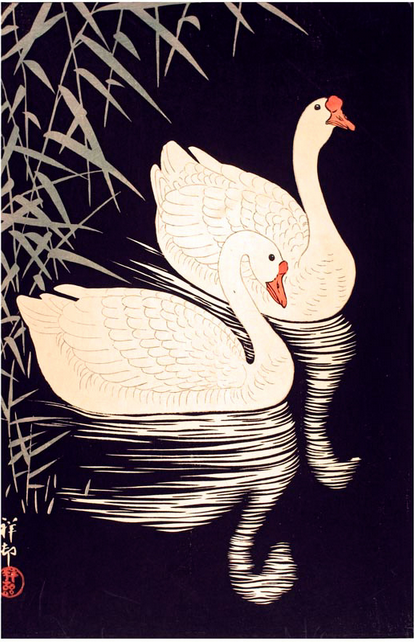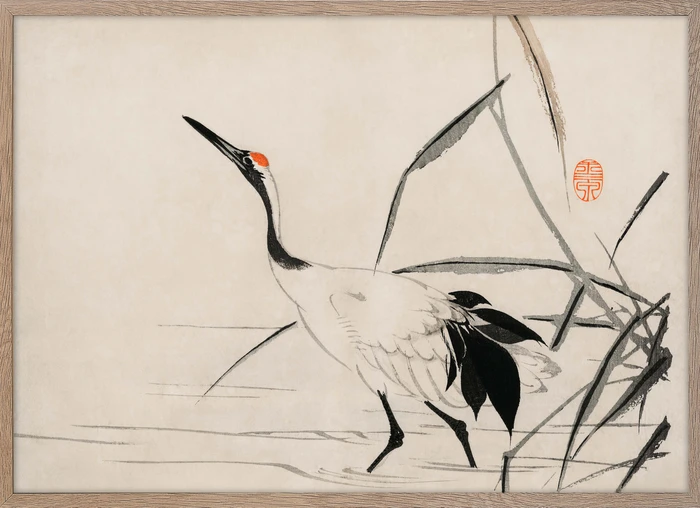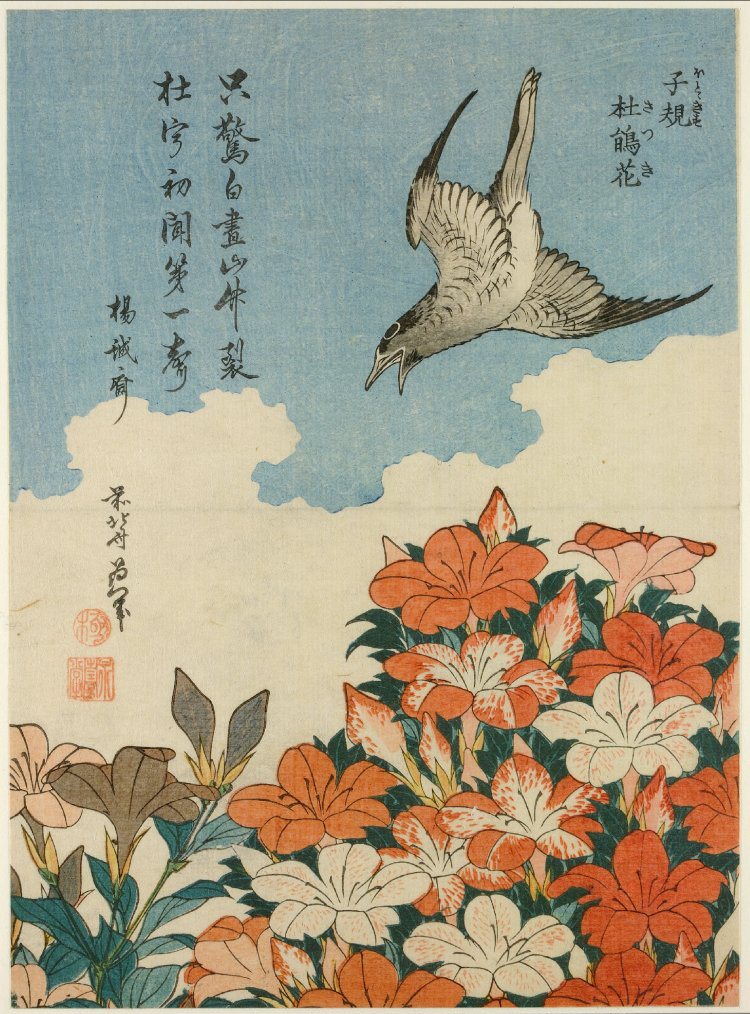Louis Benioff
Overview
Overall, this collection of prints have patterns of nature as a focus, and are a strong focal point among the 5 prints (alongside the fact that all of them depict birds.) However, I liked how the artists used distinct methods of representing and reinforcing these patterns as well, specifically national representation, culture, and the seasons.
The seasons seem to be a very big focus in many of these prints, with each bird representing different seasons or times of year. The meaning of representations differ for each bird. The cuckoo may represent the season of summer, for geese the fall and coming of winter, the pheasant evoking national pride and imagery of a mighty bird in mythology, etc.
Composition-wise, much of prints depict the birds taking up most of the space in the prints, yet do not take up all of it, leaving space for foliage, water, the sky, and other such natural spaces to reinforce and put into context the bird’s significance in the piece. Similarly, the amount of detail of the background components signal the level of importance to the bird and while sometimes something more subtle, like faint water ripples, may also be something much more bold and significant, like the azaleas from the “Cuckoo and Azaleas” print. In this print, the azaleas, cuckoo, and the sky/clouds take up about a third of the print each, displaying an equal role in portraying the beauty, variance, and seasonal importance of summer.
Similarly, the geese from “Flying Geese”, as they fly in formation likely heading to warmer lands for the winter, show an open sky or land, with the water below framing their flight. It is difficult to tell whether the background is land or sky, but regarding either, with the scarcity of foliage and smaller clouds during the autumn and winter season, it brings the feel of cold, windy, open space which is cut through with the geese, filling the empty space with a seasonal appearance of the goose flock. For what is a cool autumn sky without the formations of geese as they fly coordinated and without breaking their shape, across cold skies and water, as they head to new lands.
The pheasant, goose/duck, and crane especially evoke strong feelings of things outside of seasonal representation, also representing different aspects of people’s lives, whether that be love, longevity, luck, and other such representations of fortune and positive connotations within Japanese culture. This also showcases the ideals within Japanese culture, at least when the representations were widespread, especially with emphasis on long life and happy & long marriages.
These prints seem to be very in tune with the seasons and the nature that changes along with them, and the artists seem to create things that can capture that seasonal and nature harmony in a small sample of natural and beautiful possibilities. Birds in particular can represent anything from the aforementioned nature, to seasonal food, to even national pride and representation. All in a print with simple yet remarkably effective composition.

Title: Flying Geese
Creator: Ogata Korin (after), Japanese, 1658-1716
Work Type: Color Print
Material: Ink on paper
Date: 20th century
Measurements: 25 x 37 cm
Repository: Shain Library Collection of Japanese Prints, Connecticut College, New London
Description:
The print depicts what appears to be 5 geese flying in formation, the viewing angle seeming to be either above them as they fly, or more perpendicular to the water as they dive.
The geese seem to be depicted with different thicknesses of black ink, as the lighter gray of the main body shows the texture of the paper, suggesting a more watered down ink compared to the eyes and darker details of the body. Individual brush strokes and the color of the paper can also be seen and seen through the water, the texture and translucence something that may be more difficult to do with full thickness ink, and creating a ripple-like-pattern.
The work strongly represents the visual movement of the geese, like with a long exposure photo of birds flying, each goose depicting a moment in time where it was, and a moment in time where it was next. This creates a visual pattern that suggests movement, much like how the ripples on the surface of the lake suggest movement of the water.
The flight of Geese inspire thoughts of Fall as well as winter, as the birds migrate south. Goose meat was a luxury after the Nara and Heian periods. While Buddhist monks were prohibited to eat meat, they instead made a fried tofu and veggie substitute, Ganmodoki, which directly translates to “pseudo-goose”, which the monks used instead of goose meat in Winter hot pot dishes.

Title: Swimming swans
Creator: Ohara Shoson, Japanese, 1877-1945
Work Type: Color woodcut
Material: Ink on paper
Date: First half of 20th century
Measurements: 35 x 23 cm
Repository: Shain Library Collection of Japanese Prints, Connecticut College, New London
Description:
The print depicts two swans, presumably (from the ripples) swimming forwards, on a black background and on a black reflective surface, along with thin stalked plants in the mid-ground.
The black background and what is presumably black water, all darkened to show the only light things in the photo, the plants, the swans, and the ripples in the water which are only visible within the swan’s reflections. The only color (excluding variants of white and gray, and assuming the different shades of the swan bodies is due to discoloration?) is the orange on the heads of the swans.
Black brings complete focus on the ripple patterns, the feather patterns, and the alternating, yet somewhat organically random, patterns of the leaves, which is what the artist most likely wants us to see. The ripples of the water are also only visible within the reflection of the swans, being a literal and metaphorical reflection of the natural patterns within the feathers of the swans.
These are most likely White Chinese Geese, unlike what the original label says. The print shows one male and one female. Males typically have a bigger knob on their heads and hold a more vertical stance. Females have smaller knobs on their heads, and holds lower, more horizontal stances.
Geese are representative of fall, cooler weather giving way to the cold of winter. A male female pair of ducks/geese floating on calm water symbolizes marital harmony.

Title: Japanese Crane
Creator: Mochizuki Gyokuzen (1834-1913)
Work Type: Color Print
Material: Ink on paper
Date: 1891
Measurements: 24 x 32 cm
Repository: Flickr, Free download under CC Attribution (CC BY 4.0)
Description:
Like the reeds around it, this crane is graceful yet delicate, simple yet elegant, its body broken up by coal black feathers, snowy plumage, and a crimson cap which resembles the rising sun of the Japanese flag. The bird and the plants are depicted on a plain light background, which is broken up by the ripples in what is presumably water, which is represented by simple gray lines to use the minimal amount of line and color to show water, but also to focus almost all the attention on the centerpiece that is the crane.
Cranes are one of the most widely known birds that are often associated with Japan. Cranes symbolize longevity, and they mate for life and are also known as chitosedori, or “thousand year birds”. Therefore, they are considered lucky birds and represent good fortune.

Title: Cuckoo and Azaleas
Creator: Katsushika Hokusai. 1760-1849
Work Type: Color woodcut
Material: Ink on paper
Date: Around 1828
Measurements: 25.4 cm x 18.6 cm
Repository: Flickr, Public domain
Description:
Cuckoos are symbolic of the warm season of summer, alongside cattle and cormorants.
This piece shows a cuckoo skimming a bush of mixed azaleas. It is presumably daytime, and the clouds in the back are bunched together, thick and fluffy, most likely a huge cumulonimbus cloud. The beauty of the land, with the azalea, and the beauty of the sky, with the clouds and being traversed by the cuckoo, represents the warm seasons, with the bright blue sky which would be more gray in winter and absent of flowers, mottled with the scale-like clouds of fall, and the cuckoo present showing that it is indeed summer. No single element takes up too much space, each displaying themselves in their own spaces, a small sample of everything merging to form a small slice of a Japanese summer.

Work Type: Color woodcut
Material: Ink on paper
Date: First half of 20th century
Measurements: 35 x 14 cm
Repository: Shain Library Collection of Japanese Prints, Connecticut College, New London
Description:
The print depicts a pheasant in flight as it seems to fly out of the plants/bushes below, at an angle where almost all of its wing feathers are visible as well as its tail feathers and its main body.
The only two things depicted in the print are the pheasant and the tips of the bushes, and the only things that have color are the feathers of the bird and the leaves of the plant. This allows the viewer to focus on these two aspects of the print, and naturally moves our mind to compare the two, allowing us to notice the similarities in color, patterns, and possibly function.
The feathers and the leaves both cover an area to gain advantage of air currents and water/sunlight, respectively, and displays the beauty and patterns in nature that developed as a result of necessity in survival, yet also formed to become something humans can enjoy and appreciate as well (further depicted in nature inspired patterns, prints, and other art that shows that humans have always found beauty in the art of nature).
Pheasants are associated with spring, and Pheasants are actually the national bird of Japan.The Green Pheasant is the Japanese variety, whilst China has its Golden Pheasant. The pheasant’s feathers are beautiful, but they are also somewhat goofy birds, tending to hide in bushes with their heads hidden but their tail feathers sticking out, thinking they are hidden.
Of course, most people think of the Crane when asked if they know what the national bird of Japan is. The pheasant was chosen as the official bird in 1947, as part of a conservation initiative. Pheasants are fierce birds, with the male pheasants pecking enemies to death and risking their lives for their nest by luring snakes away from the nest with loud noise. Female pheasants have been seen sitting on and protecting their eggs even after a wildfire, their feathers singed from the heat. Then there’s the tale of Momotaro, where a Pheasant is one of the animal heroes who travel with the titular character Momotaro and become mighty demon slayers.
Goofy and cute, but also beautiful, yet also renown for their courage and strength in myth and reality, Pheasants are for sure birds worthy of taking the title of Japan’s national bird.
Bibliography
Images
Ogata Korin (after), Japanese, 1658-1716. Flying geese. 20th century. Artstor, library.artstor.org/asset/CONNASIAN_106310617185
Ohara Shoson, Japanese, 1877-1945. Flying pheasant. First half of 20th century. Artstor, library.artstor.org/asset/CONNASIAN_106310617203
Ohara Shoson, Japanese, 1877-1945. Swimming swans. First half of 20th century. Artstor, library.artstor.org/asset/CONNASIAN_106310617189
“The Ukiyo-e Illustration of a Japanese Crane by Mochizuki Gyokusen, Drawn in the Year 1891, a Traditional Portrait of an Elegant Japanese Crane. Digitally Enhanced from Our Own Original Wood Block Print.” Flickr, 15 Nov. 2021, https://flic.kr/p/26kAaK5.
“Hokusai_cuckoo_azaleas_1834.” Flickr, 15 Nov. 2021, https://flic.kr/p/zKBJVf.
Texts
“Cuckoo and Azaleas.” Cuckoo and Azaleas by Hokusai, http://japaneseprints.org/hokusai/cuckoo-and-azaleas/.
Singer, Robert T., et al. The Life of Animals in Japanese Art. National Gallery of Art, 2019.
Ko, Kyota. “[MCJ Podcast] 13. Pheasants Are the National Bird of Japan. Because They Taste Good.” The Metro-Classic Japanese, 17 June 2020, https://www.metro-classic-japanese.net/mcj-podcast-13-pheasants-are-the-national-bird-of-japan-because-they-taste-good/.
Hiroyuki, Ishi. “The Flight of the Wild Geese.” Nippon.com, 30 May 2020, https://www.nippon.com/en/features/c03902/.
Brazil, Mark. “Flight of the Swan Offers Natural Lesson.” The Japan Times, 7 Mar. 2015, https://www.japantimes.co.jp/life/2015/03/07/environment/flight-swan-offers-natural-lesson/